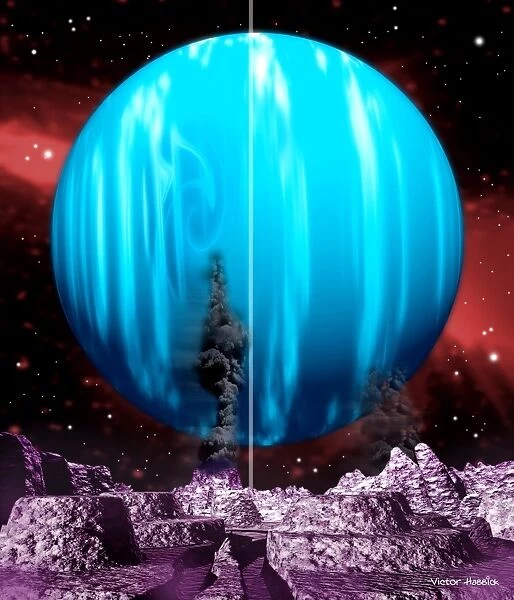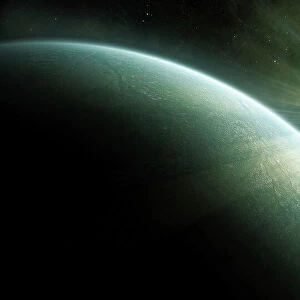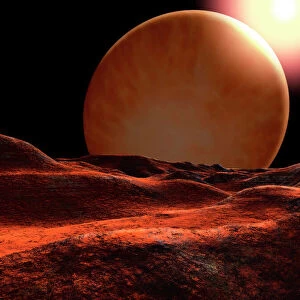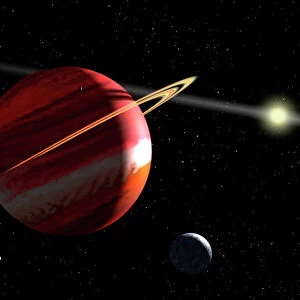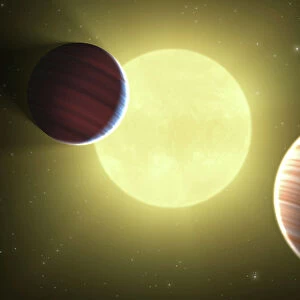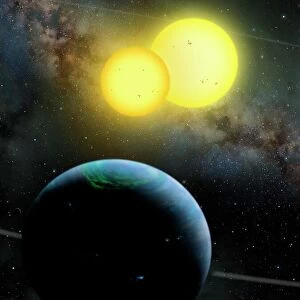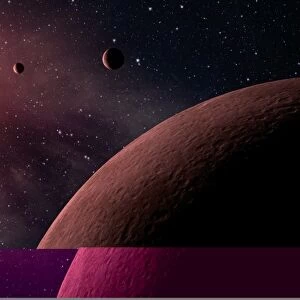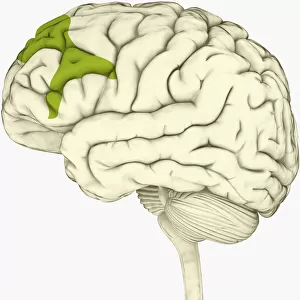Home > Science > Space Exploration > Planets > Neptune
Triton and Neptune
![]()

Wall Art and Photo Gifts from Science Photo Library
Triton and Neptune
Triton and Neptune. Computer artwork of a geyser (black) erupting from Triton, the largest moon of Neptune (blue). Triton is the coldest world in the solar system, with temperatures of -235 degrees Celsius. Some of the atmosphere of nitrogen and methane has frozen out on the surface. The Voyager 2 space probe passed near Triton in August 1989. Pictures were beamed back of dark stains in the sunlit regions. These were explained as soot, ejected by geysers of nitrogen gas, blown into streaks by the prevailing winds
Science Photo Library features Science and Medical images including photos and illustrations
Media ID 6444463
© VICTOR HABBICK VISIONS/SCIENCE PHOTO LIBRARY
Astrophysics Computer Cosmology Erupting Eruption Eruptions Geyser Geysers Moon Neptune Planetary Ringed Rings Triton
FEATURES IN THESE COLLECTIONS
> Science
> Space Exploration
> Planets
> Neptune
> Science
> Space Exploration
> Solar System
EDITORS COMMENTS
This print showcases the mesmerizing beauty of Triton and Neptune, two celestial bodies in our vast solar system. Created through computer artwork, it depicts a stunning geyser erupting from Triton, which is Neptune's largest moon. The contrasting colors of black and blue symbolize the mysterious nature of these distant worlds. Triton, known as the coldest world in our solar system, boasts bone-chilling temperatures plummeting to -235 degrees Celsius. This extreme cold has caused parts of its nitrogen and methane atmosphere to freeze out onto its surface, creating an otherworldly landscape. The Voyager 2 space probe had a close encounter with Triton back in August 1989, capturing incredible images that revealed dark stains scattered across sunlit regions. Scientists later discovered that these enigmatic marks were actually soot expelled by geysers of nitrogen gas. These geysers were further shaped into streaks by prevailing winds on this icy moon. As we gaze upon this remarkable artwork, we are reminded of the boundless wonders awaiting exploration beyond our planet Earth. It serves as a testament to humanity's insatiable curiosity about the cosmos and our relentless pursuit of knowledge in fields such as astronomy, astrophysics, cosmology, and planetary science. This awe-inspiring image was brought to life by Science Photo Library – an invaluable resource for those seeking visual representations that bridge artistry with scientific discovery.
MADE IN AUSTRALIA
Safe Shipping with 30 Day Money Back Guarantee
FREE PERSONALISATION*
We are proud to offer a range of customisation features including Personalised Captions, Color Filters and Picture Zoom Tools
SECURE PAYMENTS
We happily accept a wide range of payment options so you can pay for the things you need in the way that is most convenient for you
* Options may vary by product and licensing agreement. Zoomed Pictures can be adjusted in the Cart.

